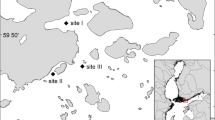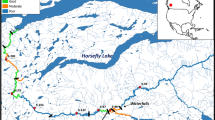Abstract
The Comprehensive Everglades Restoration includes plans to restore freshwater delivery to Taylor Slough, a shallow drainage basin in the Southern Everglades, ultimately resulting in increased freshwater flow to the downstream Taylor River estuary. The effect of altered hydrologic regime on the transport dynamics of flocculent, estuarine detritus is not well understood. We utilized a paramagnetic sediment tracer to examine detrital transport in three Taylor River pond/creek pairs during early wet versus late wet transition season estuarine flow conditions. Flux of floc tracer was greatest in the downstream direction during all observations, and was most pronounced during the early wet season, coincident with shallower water depth and faster discharge from northern Taylor River. Floc tracer was more likely to move upriver during the late wet/dry season. We observed a floc tracer transport velocity of approximately 1.74 to 1.78 m/day across both seasonal hydrologic conditions. Tracer dynamics were also surprisingly site-dependent, which may highlight the importance of channel geomorphology in regulating hydrologic and sediment transport conditions. Our data suggest that restoration of surface water delivery to Taylor River will influence downstream loading of detritus material into riverine ponds. These detrital inputs have the potential to enhance ecosystem primary productivity and/or secondary productivity.





Similar content being viewed by others
References
Azam F, Fenchel T, Field JG, Gray JS, Meyer-Reil LA, Thingstad F (1983) The ecological role of water-column microbes in the sea. Mar Ecol Prog Ser 10:257–263
Belicka LL, Sokol ER, Hoch JM, Jaffé R, Trexler JC (2012) A molecular and stable isotope approach to investigate algal and detrital energy pathways in a freshwater marsh. Wetlands 32:531–542
Best JL (1988) Sediment transport and bed morphology at river channel confluences. Sedimentology 35:481–498
Black KS, Athey S, Wilson P, Evans D (2007) The use of particle tracking in sediment transport studies: a review. In: Balson PS, Collins MB (eds) Coastal and shelf sediment transport. Geological Society of London, London, pp 73–91
Childers DL, Day JW, McKellar HN (2000) Twenty more years of marsh and estuarine flux studies: revisiting Nixon (1980). In: Weinstein MP, Kreeger DA (eds) Concepts and controversies in tidal marsh ecology. Springer, Netherlands, pp 391–423
Childers DL, Boyer JN, Davis SE, Madden CJ, Rudnick DT, Sklar FK (2006) Relating precipitation and water management to nutrient concentrations in the oligotrophic “upside-down” estuaries of the Florida Everglades. Limnol Oceanogr 51:602–616
Davis SE, Childers DL, Day JW, Rudnick DT, Sklar FH (2001) Wetland-water column exchanges of carbon, nitrogen, and phosphorus in a southern Everglades dwarf mangrove. Estuar Coasts 24:610–622
Davis SE, Childers DL, Day JW Jr, Rudnick DT, Sklar FH (2003) Factors affecting the concentration and flux of materials in two southern Everglades mangrove wetlands. Mar Ecol Prog Ser 253:85–96
Droppo IG (2001) Rethinking what constitutes suspended sediment. Hydrol Process 15:1551–1564
Droppo I, Leppard G, Flannigan D, Liss S (1997) The freshwater floc: a functional relationship of water and organic and inorganic floc constituents affecting suspended sediment properties. Water Air Soil Pollut 99:43–53
Duever MJ, Meeder JF, Meeder LC, McCollom JM (1994) The climate of South Florida and its role in shaping the Everglades ecosystem. In: Davis SM, Ogden JC (eds) Everglades: The ecosystem and its restoration. St. Lucie Press, Delray Beach, pp 225–248
Gaiser EE, Scinto LJ, Richards JH, Jayachandran K, Childers DL, Trexler JC, Jones RD (2004) Phosphorus in periphyton mats provides the best metric for detecting low-level P enrichment in an oligotrophic wetland. Water Res 38:507–516
Gaiser EE, Trexler JC, Richards JH, Childers DL, Lee D, Edwards AL, Scinto LJ, Jayachandran K, Noe GB, Jones RD (2005) Cascading ecological effects of low-level phosphorus enrichment in the Florida Everglades. J Environ Qual 34:717–723
Gaiser E, Zafiris A, Ruiz P, Tobias F, Ross M (2006) Tracking rates of ecotone migration due to salt-water encroachment using fossil mollusks in coastal South Florida. Hydrobiologia 569:237–257
Geyer WR (1997) Influence of wind on dynamics and flushing of shallow estuaries. Estuarine Coastal Shelf Sci 44:713–722
Jaffé R, Mead R, Hernandez ME, Peralba MC, DiGuida OA (2001) Origin and transport of sedimentary organic matter in two subtropical estuaries: a comparative, biomarker-based study. Org Geochem 32:507–526
Janzen CD, Wong KC (2002) Wind-forced dynamics at the estuary-shelf interface of a large coastal plain estuary. J Geophys Res 107:3138
Koch GR, Childers DL, Staehr PA, Price RM, Davis SE, Gaiser EE (2012) Hydrological conditions control P loading and aquatic metabolism in an oligotrophic, subtropical estuary. Estuar Coasts 35:292–307
Kristensen E, Bouillon S, Dittmar T, Marchand C (2008) Organic carbon dynamics in mangrove ecosystems: a review. Aquat Bot 89:201–219
Larsen Laurel G, Harvey Judson W (2010) How vegetation and sediment transport feedbacks drive landscape change in the Everglades and wetlands worldwide. Am Nat 176:E66–E79
Larsen LG, Harvey JW, Crimaldi JP (2007) A delicate balance: ecohydrological feedbacks governing landscape morphology in a lotic peatland. Ecol Monogr 77:591–614
Larsen LG, Harvey JW, Crimaldi JP (2009) Morphologic and transport properties of natural organic floc. Water Resour Res 45:W01410
Light SS, Dineen JW (1994) Water control in the Everglades: a historical perspective. In: Davis SM, Ogden JC (eds) Everglades: The ecosystems and its restoration. St. Lucie Press, Delray Beach
Liss SN, Droppo IG, Flannigan DT, Leppard GG (1996) Floc architecture in wastewater and natural riverine systems. Environ Sci Technol 30:680–686
Lobry J, David V, Pasquaud S, Lepage M, Sautour B, Rochard E (2008) Diversity and stability of an estuarine trophic network. Mar Ecol Prog Ser 358:13–25
McVoy C, Park Said W, Obeysekera J, VanArman J, Dreschel T (2011) Landscapes and hydrology of the predrainage Everglades. University Press of Florida, Gainesville
Mead R, Xu Y, Chong J, Jaffé R (2005) Sediment and soil organic matter source assessment as revealed by the molecular distribution and carbon isotopic composition of n-alkanes. Org Geochem 36:363–370
Michot B, Meselhe EA, Rivera-Monroy VH, Coronado-Molina C, Twilley RR (2011) A tidal creek water budget: estimation of groundwater discharge and overland flow using hydrologic modeling in the Southern Everglades. Estuarine Coastal Shelf Sci 93:438–448
Neto R, Mead R, Louda J, Jaffé R (2006) Organic biogeochemistry of detrital flocculent material (floc) in a subtropical, coastal wetland. Biogeochemistry 77:283–304
Nixon SW (1980) Between coastal marshes and coastal water: a review of twenty years of speculation and research on the role of salt marshes in estuarine productivity and water chemistry. In: Hamilton P, MacDonald K (eds) Estuarine and Wetland processes. Plenum, New York, pp 438–525
Noe GB, Childers DL, Jones RD (2001) Phosphorus biogeochemistry and the impact of phosphorus enrichment: why is the Everglades so unique? Ecosystems 4:603–624
Noe GB, Childers DL, Edwards AL, Gaiser E, Jayachandran K, Lee D, Meeder J, Richards J, Scinto LJ, Trexler JC, Jones RD (2002) Short-term changes in phosphorus storage in an oligotrophic Everglades wetland ecosystem receiving experimental nutrient enrichment. Biogeochemistry 59:239–267
Noe GB, Scinto LJ, Taylor J, Childers DL, Jones RD (2003) Phosphorus cycling and partitioning in an oligotrophic Everglades wetland ecosystem: a radioisotope tracing study. Freshw Biol 48:1993–2008
Odum EP (1968) A research challenge: evaluating the productivity of coastal and estuarine water. Proceedings of the Second Sea Grant Conference, University of Rhode Island pp. 63–64
Odum EP (1969) The strategy of ecosystem development. Science 164:262–270
Odum EP (1980) The status of three ecosystem-level hypotheses regarding salt marsh estuaries: tidal subsidy, outwelling, and detritus-based food chains. In: Kennedy VS (ed) Estuarine perspectives. Academic, New York, pp 485–495
Odum WE, Heald EJ (1975) The detritus-based food web of an estuarine community. In: Cronin LE (ed) Estuarine research, Vol. 1. Academic, New York, pp 265–286
Odum WE, Fisher JS, Pickral JC (1979) Factors controlling the flux of particulate organic carbon from estuarine wetlands. In: Livingston RJ (ed) Ecological processes in coastal and marine systems. Plenum Press, New York, pp 69–80
Pisani O, Yamashita Y, Jaffé R (2011) Photo-dissolution of flocculent, detrital material in aquatic environments: contributions to the dissolved organic matter pool. Water Res 45:3836–3844
Ross MS, Meeder JF, Sah JP, Ruiz PL, Telesnicki GJ (2000) The Southeast saline Everglades revisited: 50 years of coastal vegetation change. J Veg Sci 11:101–112
Sklar FH, Chimney MJ, Newman S, McCormick P, Gawlik D, Miao S, McVoy C, Said W, Newman J, Coronado C, Crozier G, Korvela M, Rutchey K (2005) The ecological–societal underpinnings of Everglades restoration. Front Ecol Environ 3:161–169
Sutula MA, Perez BC, Reyes E, Childers DL, Davis S, Day JW Jr, Rudnick D, Sklar F (2003) Factors affecting spatial and temporal variability in material exchange between the Southern Everglades wetlands and Florida Bay (USA). Estuarine Coastal Shelf Sci 57:757–781
Teal JM (1962) Energy flow in the salt marsh ecosystem of Georgia. Ecology 43:614–624
Troxler TG, Richards JH (2009) δ13C, δ15N, carbon, nitrogen and phosphorus as indicators of plant ecophysiology and organic matter pathways in Everglades deep slough, Florida, USA. Aquat Bot 91:157–165
Van den Meersche K, Van Rijswijk P, Soetaert K, Middelburg JJ (2009) Autochthonous and allochthonous contributions to mesozooplankton diet in a Tidal River and estuary: integrating carbon isotope and fatty acid constraints. Limnol Oceanogr 54:62–74
Vitousek P (1982) Nutrient cycling and nutrient use efficiency. Am Nat 119:553–572
Vitousek PM, Sanford RL Jr (1986) Nutrient cycling in moist tropical forest. Annu Rev Ecol Syst 17:137–167
Weisberg RH (1976) The nontidal flow in the providence River of Narragansett Bay: a stochastic approach to estuarine circulation. J Phys Oceanogr 6:721–734
Williams AJ, Trexler JC (2006) A preliminary analysis of the correlation of food-web characteristics with hydrology and nutrient gradients in the southern Everglades. Hydrobiologia 569:493–504
Zapata-Rios X, Price RM (2012) Estimates of groundwater discharge to a coastal wetland using multiple techniques: taylor Slough, Everglades National Park, USA. Hydrogeol J 20:1651–1668
Acknowledgments
We thank two anonymous reviewers as well as Colin Saunders and Carlos Coronado of the South Florida Water Management District for their reviews that greatly improved the quality of this manuscript. Steven Davis, René Price, and Jennifer Richards provided helpful feedback on earlier versions of the text. We would also like to thank Damon Rondeau, Rafael Travieso, and Adam Hines for help with field logistics. This publication was produced as part of a special issue devoted to investigating the ecological response of over 20 years of hydrologic restoration and active management in the Taylor Slough drainage of Everglades National Park. Support for this special issue was provided by: the Everglades Foundation, Everglades National Park, the Florida Coastal Everglades Long-Term Ecological Research program (National Science Foundation cooperative agreement #DBI-0620409 and #DEB-9910514), the South Florida Water Management District, and the Southeast Environmental Research Center. The views expressed in this paper are those of the authors and do not necessarily reflect the views or policies of the U.S. Environmental Protection Agency. This paper is contribution #563 from the Southeast Environmental Research Center at Florida International University.
Author information
Authors and Affiliations
Corresponding author
Rights and permissions
About this article
Cite this article
Koch, G.R., Hagerthey, S., Childers, D.L. et al. Examining Seasonally Pulsed Detrital Transport in the Coastal Everglades Using a Sediment Tracing Technique. Wetlands 34 (Suppl 1), 123–133 (2014). https://doi.org/10.1007/s13157-013-0388-y
Received:
Accepted:
Published:
Issue Date:
DOI: https://doi.org/10.1007/s13157-013-0388-y




